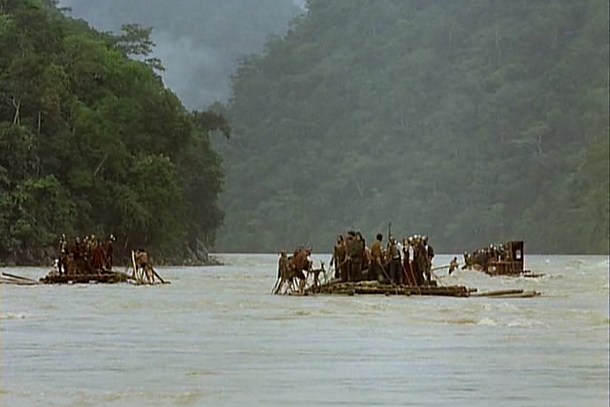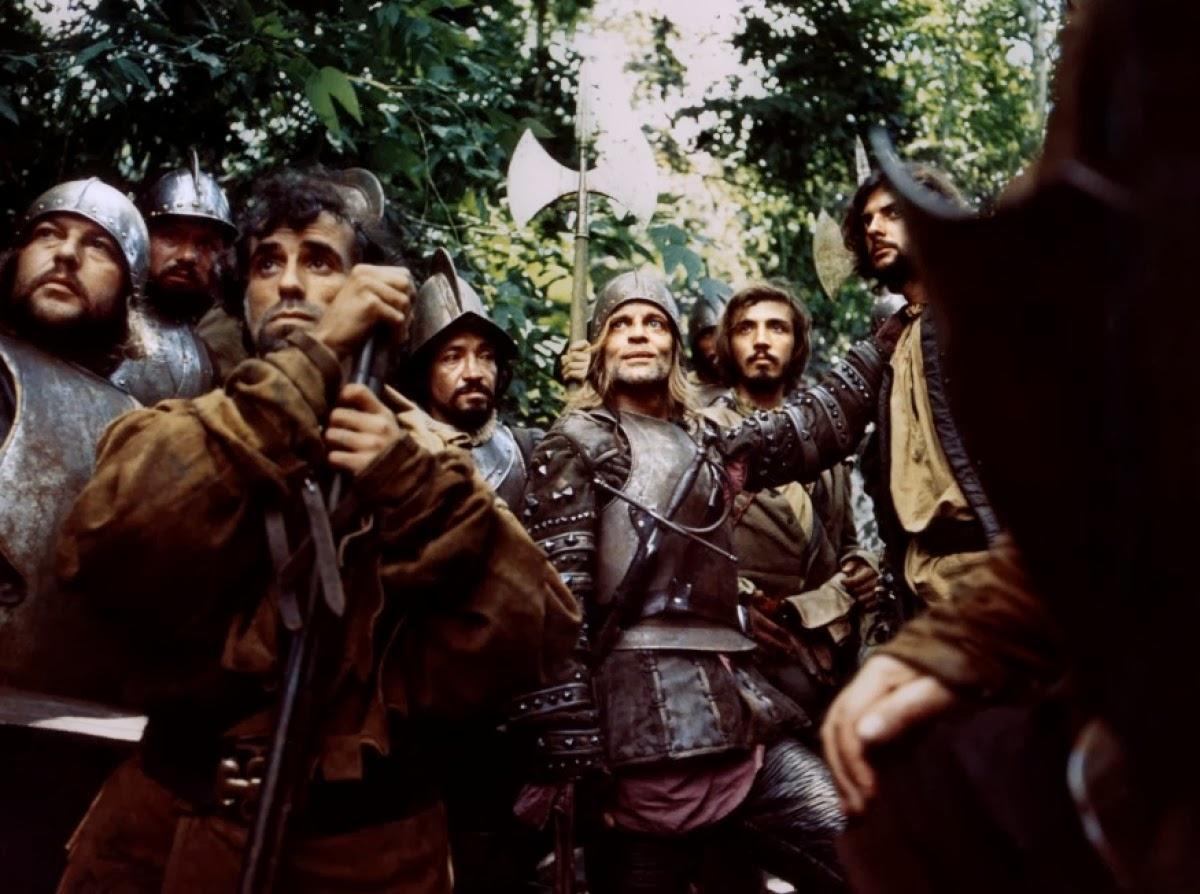- Director: Werner Herzog
- Writer: Werner Herzog
- Starring: Klaus Kinski, Helena Rojo, Ruy Guerra, Del Negro, Peter Berling, Cecilia Rivera, Daniel Ades, Edward Roland, Armando Polanah, Alejandro Rupellés, and Justo González
- Accolades: 2012 Sight & Sound Top 100 list (#90)
- Where to Watch: Free streaming on ShoutTV app, free streaming (with ads) on Tubi app and Pluto TV, stream with subscription on Amazon Video, buy or rent on Amazon Video, YouTube, or Apple TV
There are actors known as “method actors,” because they try to disappear inside their characters. Aguirre, der Zorn Gottes is a movie that somehow disappears inside its story. It’s a story about folly and madness as a bunch of Europeans head up the Amazon river on rafts, so to shoot it director Werner Herzog trucked an entire movie crew out to the actual Amazon jungle and shot the movie on rickety rafts just like those in the movie. The movie was originally shot in English, the only language the cast and crew from 16 different countries had in common, but partway through the shoot the sound guy suddenly quit and took his equipment with him. The re-recording, back in Germany, ended up being in German. His lead actor, Klaus Kinski, may literally have been insane, and also repeatedly threatened to quit. There’s a movie buff version of an urban legend that Herzog literally forced Kinski to keep acting at gunpoint. Kinski later denied this, darkly adding, “I had the only gun.”
Aguirre, der Zorn Gottes (translated to English as Aguirre, the Wrath of God) tells a heavily fictionalized version of a real story involving Spanish conquistadors in 1560s South America. It starts with an absolutely incredible shot of the massive expedition climbing down a mountain amidst the clouds (this sequence was shot in Peru on the slopes below Macchu Picchu). There are conquistadors in full medieval armor and dozens of natives. One guy walks past the camera just carrying a big statue of the Virgin Mary for some reason. Their mission is to find the legendary golden city of El Dorado. That is not how things turn out.

Gradually, everything goes badly. Aguirre (Kinski), the expedition’s second in command, leads a mutiny against the more practical commander Ursua (Ruy Guerra) when he tries to turn back. Aguirre appoints the lazy, seemingly easily manipulable Don Fernando (Peter Berling) as not only the new leader of the expedition, but declares independence from the King of Spain and that Fernando is the new “Emperor.” As everyone heads up the river, death and madness starts picking them off. Arrows and spears emerge from the jungle silently. They capture a native with a gold necklace and ask him where he got it. He gestures vaguely up the river. Then the expedition’s priest (Del Negro) hands the guy a bible and says it’s the “Word of God.” The native holds it up to his ear and says he can’t hear anything. They execute him for blasphemy and then Aguirre punches a horse in the face.
Discontent grows and numbers dwindle. They try to capture a local village but a couple guys get shot by arrows and they blow up a wooden hut with a cannon. Fernando is fed with fish and fruit while the rest of the men count out the last kernels of corn, then throws the horse overboard after it annoys him. The men grumble, and then Fernando is found garroted. When only a few people are left, Aguirre sends Ursua into the jungle to be hanged, even though he’s dying. He overhears one guy talking about leaving, sneaks up behind him, and chops off his head, so suddenly that the severed head then finishes its sentence. “If I say the birds will fall from the trees, the birds will fall from the trees!” Aguirre screams. “I am the wrath of God!” He still plotting his future empire (screaming about how he’ll “marry his daughter and have the purest dynasty in history,” not long after she dies in his arms) in the movie’s final shot, in which he is the last one left alive, surrounded by chattering monkeys and dead bodies.

Herzog may be known to the greatest number of people today as the guy who wants to kill Baby Yoda in The Mandalorian, but decades before that he was one of the most influential world filmmakers of his era. Growing up in post-World War II West Germany, he later recounted traveling actor Klaus Kinski coming to stay in his parents’ rooming house, and claimed that at that moment he realized that he was “destined to make films, and Kinski was destined to star in them.” In the end, they would collaborate on a total of five films, with Herzog making many more besides. He later admitted that he shot his first several films, including Aguirre, on a camera he stole from a university film school in Munich. “I don’t consider it theft. It was just a necessity. I had some sort of natural right for a camera, a tool to work with,” he said.
That off-center point of view and voice would lead to Herzog’s second act, as a documentarian, with his distinctive, slow, bizarre narration. His more famous efforts include Grizzly Man (about a man who insisted on living with grizzly bears and was eventually killed by them), Encounters at the End of the World (about people who live and work in Antarctica), Cave of Forgotten Dreams (about the Lascaux cave in France with some of the oldest known cave paintings), and last year’s Fireball: Visitors From Darker Worlds, about asteroids and the people obsessed with them, released directly to Apple TV. On his way to shooting Aguirre, he changed planes at the last minute, and the plane he was supposed to be on crashed, killing everyone aboard except for one person. He later directed a documentary about the woman who survived, Wings of Hope. He also made a film about his own relationship with Kinski, entitled My Best Fiend.

Herzog believes in a unique alchemy from shooting on location, which is certainly on display all through this bizarre movie. Despite all the problems, he returned again to South America to shoot Fitzcarraldo, about an insane Irish rubber baron who has a full-on riverboat carted over a mountain on ropes in order to reach the rubber trees on the other side. Of course, Herzog’s method of shooting this involved literally dragging the boat over a mountain on ropes himself, despite being warned repeatedly by engineers that the ropes would snap and slice everyone in half, all while Kinski, playing the title role, went nuts. This whole process was documented in Burden of Dreams, one of the more famous “making of” documentaries in movie history. Among those movies perhaps only slightly less directly influenced by Aguirre were Apocalypse Now (which tells a very similar story of traveling up a river while slowly going insane) and Terence Malick’s more recent The New World, which was something of a box office dud at the time but has a very similar feel and has become something of a favorite of critics (and me) since.
Most movies you’re going to watch, on their most basic level, are telling a story, right? Well, Werner Herzog movies mostly tend not to do that. There are things that happen in Aguirre, but it’s more about creating a certain feeling. Before the first shot hits the screen, there are title cards that tell us the expedition was never seen again and the only record was the diary of the priest. He occasionally cuts in to narrate his diary entries, in dry, German, Herzog-ian fashion. The point is, the fate of all of the characters is never in question. It’s sort of The Blair Witch Project, but instead of an evil witch the only villain is human folly. Near the end of the movie, a man exclaims that he sees a ship up in a tree. The priest tells him that he’s just hallucinating, that’s clearly impossible. Then the priest gets hit with an arrow, silently shot from the jungle. The perpetrator is never seen. He looks down at the arrow and says, “it’s not real,” then collapses. A minute later, a shot shows a full European sailing ship, somehow stuck up in a tree in the Amazon. Is it really there? If so, how? The characters can’t know, and neither can we.


Werner Herzog was the guest star on The Mandalorian who told the showrunners to not be cowards and use a puppet for The Child (Baby Yoda) instead of relying on CGI. He wanted to act with a real puppet rather than a fake green screen. And thus history is made.
LikeLike